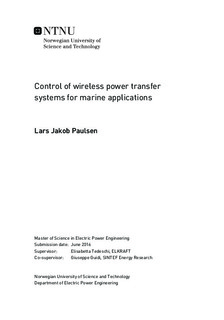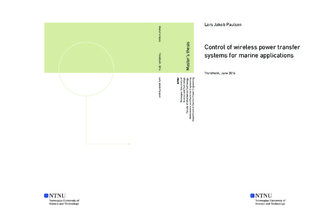| dc.description.abstract | This report is a master thesis whose purpose is to show the steps in designing a control system used for regulating a system for inductive power transfer (IPT) of marine vessel and offshore applications.
The constant increase in focus on green energy and CO2-emission reductions has led to an increase in electrification. Especially electrification of the transportation sector has great impact on the global CO2-emissions, thus the amount of vehicles and marine vessels that runs on electricity has increased rapidly and still is. This is where wireless power transfer (WPT) will be an important technology. Wireless power transfer refers to the art of transferring power without the need of physical contact. In this thesis only inductive power transfer (IPT) will be covered, because it is the most promising technology for charging vehicles and providing large power transfer to vessels or offshore applications. Inductive power transfer is in principle a coreless transformer that transfers power via the induced magnetic field created by the coil on the sending side that induces currents in the coil on the load side. This technology has several perks compared to cables, such as: increased safety, easy to connect, minimizes the need for maintenance of the power supply and it is well suited for rough environments.
During the autumn 2015, some models of a basic IPT-system were made, and measurements of a working IPT prototype were done. The prototype was part of a SINTEF project on battery charging marine vessels. This thesis is the continuation of this project, and the objectives are to upgrade the average, nonlinear time-invariant model found in the project work and then linearize it. The linearized model is then analyzed for six different cases where the coupling coefficient is changed and the respective transfer functions are extracted. The transfer functions are analyzed with respect to control theory, and the possibility of second order approximations are tested. Finally the design procedure of an initial controller for the IPT system is done by the use of MatLab/Simulink.
The results from the analysis of the transfer functions shows that the transfer functions have valid second order approximations at low coupling coefficients, but as the coupling gets stronger (coils are separated by a smaller air gap) the approximation becomes invalid. The second order design methods provide the best tools for handling design of a controller, but because systems may not always be represented by a second order approximations in its operation range, Other methods should be explored. For the area that cannot be approximated, design using computer tools are proposed. The theory behind the computer tools should be further studied in order to more easily design controllers that can adapt to changes in the system transfer function according to the coupling of the coils.
For further work I propose to look more into the second order approximation to be able to represent more transfer functions as second order approximations. Additionally, the relationship between the coupling coefficient and how the poles and zeroes are located should be looked into. The mathematical model, based on coupled mode theory, used to model the IPT-system should be further developed. | |

